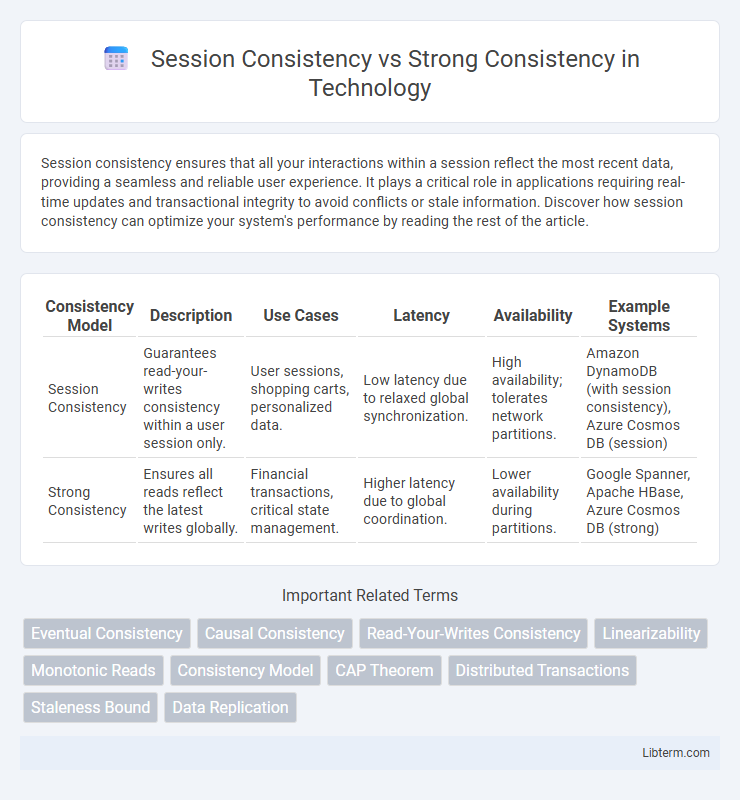Session consistency ensures that all your interactions within a session reflect the most recent data, providing a seamless and reliable user experience. It plays a critical role in applications requiring real-time updates and transactional integrity to avoid conflicts or stale information. Discover how session consistency can optimize your system's performance by reading the rest of the article.
Table of Comparison
| Consistency Model | Description | Use Cases | Latency | Availability | Example Systems |
|---|---|---|---|---|---|
| Session Consistency | Guarantees read-your-writes consistency within a user session only. | User sessions, shopping carts, personalized data. | Low latency due to relaxed global synchronization. | High availability; tolerates network partitions. | Amazon DynamoDB (with session consistency), Azure Cosmos DB (session) |
| Strong Consistency | Ensures all reads reflect the latest writes globally. | Financial transactions, critical state management. | Higher latency due to global coordination. | Lower availability during partitions. | Google Spanner, Apache HBase, Azure Cosmos DB (strong) |
Introduction to Data Consistency Models
Session consistency ensures a user sees their own updates immediately within a session, providing a coherent experience in distributed systems. Strong consistency guarantees all users view the most recent data simultaneously, maintaining strict synchronization across replicas. These data consistency models balance latency and reliability, critical for applications requiring either real-time updates or eventual convergence.
Defining Session Consistency
Session consistency guarantees that within a single client session, all read operations reflect the most recent writes performed by that client, ensuring a coherent view of data without global synchronization. This model provides a balance between latency and consistency by allowing fast, local reads while maintaining the order of operations for each session. Unlike strong consistency, which enforces a uniform data state across all clients immediately, session consistency offers a practical compromise suitable for user-centric applications where session-specific data freshness is critical.
What is Strong Consistency?
Strong consistency ensures that all read operations return the most recent write across all replicas in a distributed system, providing a single, up-to-date view of the data at any time. This guarantees linearizability, where every operation appears instantaneous and ordered globally, making it critical for applications requiring accurate and immediate data accuracy. Unlike session consistency, strong consistency prevents stale reads even when multiple clients access the data concurrently.
Key Differences Between Session and Strong Consistency
Session consistency guarantees that within a single client session, all read operations reflect the most recent write, ensuring a consistent view without requiring global synchronization. Strong consistency enforces that all clients see the same data simultaneously by synchronizing updates across all replicas immediately. Key differences include that session consistency limits consistency guarantees to a session scope with potentially faster performance, while strong consistency imposes higher latency due to global coordination but provides uniform data visibility across all clients.
Use Cases for Session Consistency
Session consistency is ideal for user-centric applications like social media platforms and personalized shopping carts, where operations must reflect the most recent user interactions within a session. It ensures a consistent view of data during a session without the overhead of global synchronization, making it suitable for real-time collaboration tools and interactive gaming environments. These use cases benefit from low latency and the guarantee that once a user writes data, subsequent reads in the same session will see that data.
When to Choose Strong Consistency
Strong consistency ensures that all users see the most recent data immediately after any update, making it essential for applications requiring accurate, real-time information such as financial transactions, inventory management, or booking systems. Choose strong consistency when the cost of stale or conflicting data outweighs the performance trade-offs, guaranteeing data integrity and preventing anomalies. Systems handling critical operations, legal records, or user authentication benefit from strong consistency to maintain correctness across distributed environments.
Performance Implications of Each Model
Session consistency offers faster read/write performance by ensuring that a user sees their own recent updates without waiting for global synchronization, making it suitable for applications requiring low latency and user-specific data coherence. Strong consistency guarantees that all users access the most recent data across the system, but this global synchronization introduces higher latency and reduces throughput due to coordination overhead and potential network delays. Choosing session consistency improves performance in distributed systems with geographically dispersed users, while strong consistency is preferred when data integrity and accuracy across all nodes are critical despite the performance trade-offs.
Real-World Examples: Session vs Strong Consistency
Session consistency ensures that a user observes their own writes within a session, ideal for applications like social media feeds where the latest user actions must be immediately visible to them but not necessarily to others. Strong consistency guarantees that all users see the most recent updates simultaneously, critical for banking systems where accurate balance updates prevent overdrafts or errors. Real-world implementations include DynamoDB's session consistency for user-specific data and Spanner's strong consistency for global financial records.
Best Practices for Implementing Consistency Models
Session consistency ensures that a user reads their own writes within a session, improving user experience without sacrificing performance. Strong consistency guarantees that all users see the most recent write, ideal for critical applications requiring accurate data synchronization. Best practices recommend using session consistency for scalable, responsive applications, while implementing strong consistency through distributed consensus protocols like Paxos or Raft when data correctness is paramount.
Conclusion: Selecting the Right Consistency for Your Application
Choosing between session consistency and strong consistency hinges on the specific needs of your application's data accuracy and user experience. Session consistency is ideal for applications requiring a balance of performance and data freshness within user sessions, such as personalized dashboards or shopping carts. Strong consistency suits scenarios demanding absolute real-time accuracy across all users, like financial transactions or critical inventory systems, ensuring every read reflects the latest write without delay.
Session Consistency Infographic

 libterm.com
libterm.com